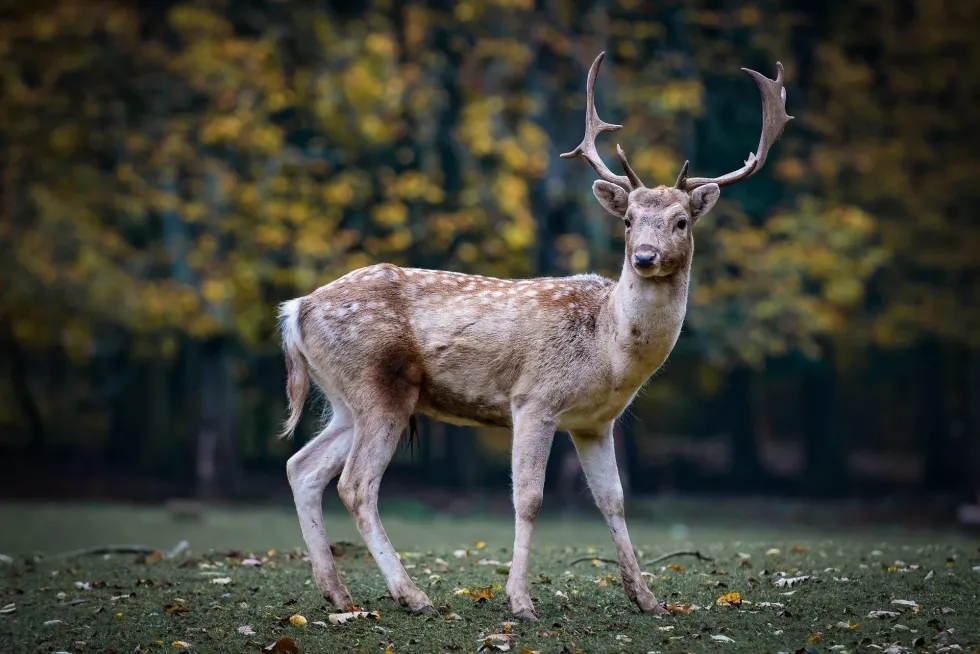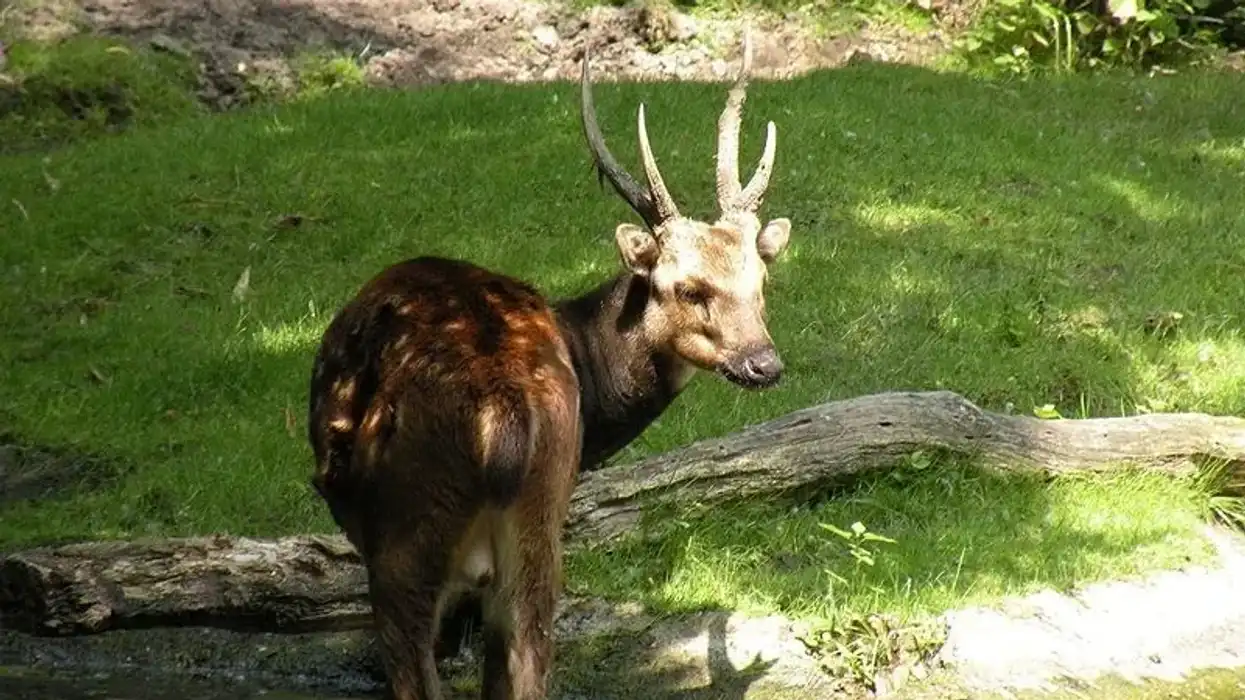The leaf muntjac (Muntiacus putaoensis) or barking deer was first discovered by the biologist Alan Rabinowitz who found a carcass of this species on an expedition in the eastern side of Northern Myanmar. At first, he thought this was a regular muntjac but upon DNA scaling, a new species of muntjac was discovered.
The Barking deer or leaf muntjac is a very beautiful animal that lives in dense forests of Asia. Seeing them even in their natural habitat is extremely rare since it is difficult to spot them due to their solitary nature of living.
It is incredible how they were not the subject of the search for this expedition led by Rabinowitz but they were still found.
This discovery by Rabinowitz is one for the history books. They feed on fruits and fallen leaves and are food to predators like tigers and leopards.
We do not know much about them because of how hard it is to find them. Inaccessible terrain makes expedition and observation an uphill task.
However, these are the things we do know about this extremely amazing animal. Quench your thirst for information about the leaf muntjac (Muntiacus putaoensis) by reading this article. If you want to know about more animals, refer to our articles on Bontebok and Takins.
Leaf Deer Interesting Facts
What type of animal is a leaf deer?
The leaf muntjac is a small-sized species of deer that belongs to the Cervidae family. They are quite different from ordinary deer.
What class of animal does a leaf deer belong to?
Leaf deer belong to the Mammalia class of animals.
How many leaf deers are there in the world?
The accurate number of leaf deers or muntjacs found in the world is not known due to insufficient data. They live in areas that are inaccessible to human beings. Therefore, it is hard to search for them and travel for observation. Their solitary lifestyle does not make the task any easier.
Where does a leaf deer live?
Leaf deer live in temperate and tropical forests. They are found in the mountainous part of these forests. They have been spotted in parts of Arunachal Pradesh, Nagaland, Western Ghats of India, and in the dense forests of Myanmar. Their distribution description extends from the forests of India to Northern Myanmar.
What is a leaf deer's habitat?
Leaf deer live in dense temperate and tropical forests. They usually prefer to live in the mountainous part of these forests at the altitude of 1476.4-1968.5 ft (450-600 m).
Who do leaf deers live with?
Leaf deer are animals that prefer to live alone. This nature of their living makes them very similar to ancient species of deers. Since they live alone and in areas that are inaccessible for human beings to reach, very little is known about them.
How long does a leaf deer live?
The information regarding the lifespan of a leaf deer (Muntiacus putaoensis) is unknown. They have been discovered but have a very scant description because of lacking knowledge on our part.
How do they reproduce?
A leaf deer (Muntiacus putaoensis) does not have a defined birthing pattern and gives birth around the year. A male leaf deer mates when its antlers are hard, which results in a regular birthing pattern.
Pregnant leaf deers have been observed in the month of May. Their reproduction season sometimes matches that of a regular muntjac or a Reeves's muntjac but for the most part, there is no consistency in this data.
What is their conservation status?
We do not know much about the species due to their habitat, behavior and solitary style of living. They are categorized as Data Deficient by the IUCN.
This could also be due to the fact that they are relatively a new species of muntjac for us.
There have been pieces of evidence of rampant hunting of the muntjac species by humans which might suggest their decreasing number but this assumption is a stretch as there is no conclusive data to prove it.
Their distribution across the forests of Northern Myanmar and parts of India might be uneven which could be a possible inference to come to this conclusion.
Leaf Deer Fun Facts
What do leaf deers look like?
Leaf deer are the smallest known muntjacs in the world that are known to us. They have small, rounded ears which are commonly ripped.
This is taken to be a sign of their frequent fights with other animals but they are not known to be violent creatures. So, take this as a physical characteristic of leaf dears.
On their forehead, they have a patch of long hair which forms a tuft. They have dark facial markings and white fur on their abdomen.
Female leaf dears turn darker in the spring, probably to avoid being noticed by predators. Fawns or baby leaf deer are a rich chestnut color, but they lack spots, unlike other muntjacs.
As they grow up, this rich chestnut color turns into a yellowish-brown shade, which is adorned by the barking deer or leaf deer. Males and females do not exhibit sexual dimorphism in size but male antlers are relatively shorter than females.
Antlers are usually shown off by older leaf deers but occasionally, you may spot a 22-month-old young deer with an antler as well. Currently, we do not have enough description of leaf deers due to several factors.
Their distribution in forests is uneven and they are still a new species of muntjac for human beings. However, on average males and females exhibit these physical features.
 *We've been unable to source an image of leaf deer and have used an image of Roe deer instead. If you are able to provide us with a royalty-free image of leaf deer, we would be happy to credit you. Please contact us at hello@kidadl.com.
*We've been unable to source an image of leaf deer and have used an image of Roe deer instead. If you are able to provide us with a royalty-free image of leaf deer, we would be happy to credit you. Please contact us at hello@kidadl.com.
How cute are they?
Leaf deer (Muntiacus putaoensis) are adorable to look at. They are small in size and their eyes, ears, and antlers add to this attribute.
How do they communicate?
This species has a short bark which is similar to that of a dog. This is the reason why they are also called 'barking deer.' The leaf deer are a very peaceful and quiet species. Deers grunt and snort as a part of their communication.
They also use body language to communicate. They have a specific type of posture for every circumstance. For instance, when they are scared or alert, they raise their ears and widen their eyes.
How big is a leaf deer?
A leaf muntjac is 20 in (50.8 cm) long and 21 in (53.3 cm) tall. They weigh approximately 25 lb ( 11.3 kg). It can be said that they are four times the size of an average cat.
How fast can a leaf deer run?
The speed of a leaf deer is currently not known. However, in general, deers can run about 49 mph (78.85 kph).
How much does a leaf deer weigh?
A leaf muntjac weighs 25 lb ( 11.3 kg).
What are the male and female names of the species?
Male and female leaf muntjac are not known by different names.
What would you call a baby leaf deer?
A baby barking deer is called a fawn.
What do they eat?
They are frugivores which means that their diet consists of fallen fruits, blades of leaves, nuts, and berries.
Are they dangerous?
This muntjac species does not appear to be dangerous to either human beings or other animals living in the forest. Since they survive on fallen fruits and leaves, they do not prey on any animals. They are in constant danger of being hunted by tigers, leopards, and humans
Would they make a good pet?
A leaf deer cannot be kept as a pet as it can be difficult for them to survive outside of their habitat. There have been instances of deers getting violent and attacking humans around them.
If they are kept in confinement, they can develop chronic diseases like tuberculosis. Therefore, it is not fair to confine them within the boundaries of your home when they prefer dense forests much more.
Did you know...
We never knew that there are different species of muntjacs found in the world. Taxologists and ecologists thought that there is only a single species of muntjac in the world and that is the regular muntjac. However, now we have new information about the existence of three different species of leaf muntjac in India alone.
Muntiacus putoensis are called leaf deer because of their size. Native hunters say that their bodies can be wrapped up completely in a single leaf.
Are leaf deers endangered?
Currently, the accurate population of leaf deers is not known and the IUCN categorizes them under Data Deficient animals. However, we know that this species of muntjac is widely hunted by hunters for economic value. They might not be endangered as of now, but there are increasing chances of the situation getting worse.
How do you identify a leaf deer?
You can identify a leaf deer, which is one of the species of muntjac, by their round, small and ripped ears. Their antlers are also telling of their species.
Other than that, they are yellowish-brown in color and have a tuft on their forehead. Their described physical attributes are very distinct and make them easily recognizable. For example, their yellow body and small figure should be an easy giveaway.
Here at Kidadl, we have carefully created lots of interesting family-friendly animal facts for everyone to discover! Learn more about some other mammals from our Chinese Water Deer facts and Fallow Deer facts pages.
You can even occupy yourself at home by coloring in one of our free printable deer coloring pages.




 *We've been unable to source an image of leaf deer and have used an image of Roe deer instead. If you are able to provide us with a royalty-free image of leaf deer, we would be happy to credit you. Please contact us at hello@kidadl.com.
*We've been unable to source an image of leaf deer and have used an image of Roe deer instead. If you are able to provide us with a royalty-free image of leaf deer, we would be happy to credit you. Please contact us at hello@kidadl.com.



